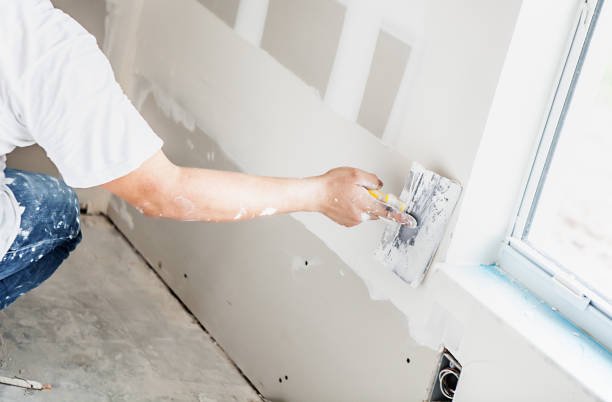Drywall is a crucial component of any home or commercial building, providing a smooth and polished look to interiors. Over time, wear and tear, accidental damage, or moisture issues can lead to cracks, holes, or dents. If left unaddressed, these imperfections can affect both the appearance and structural integrity of your walls. At Rockstar Painting, we specialize in professional drywall repair to restore your walls to their original perfection.
Why Drywall Repair is Important
Damaged drywall is more than just an aesthetic issue. Cracks and holes can weaken your walls, allowing moisture to seep in and lead to mold growth. Proper drywall repair ensures your walls remain strong, smooth, and long-lasting.
Common Causes of Drywall Damage
Understanding what causes drywall damage can help prevent future repairs. Some common causes include:
- Water Damage: Leaky roofs, plumbing issues, or high humidity can weaken drywall.
- Accidental Impact: Moving furniture, children playing, or door handles hitting walls can create holes and dents.
- Settling of the House: Over time, a building naturally shifts, leading to small cracks in the drywall.
- Pest Infestation: Termites and rodents can chew through drywall, causing structural concerns.
- Improper Installation: Poor installation techniques can lead to early wear and tear.
Tools and Materials Needed for Drywall Repair
Before beginning any drywall repair project, gathering the right tools and materials is essential. Some commonly used items include:
- Drywall patches or mesh tape
- Joint compound (spackle or mud)
- Putty knife or drywall knife
- Sandpaper or sanding block
- Primer and paint
Step-by-Step Drywall Repair Guide
Assess the Damage
Examine the extent of the damage. Small holes and cracks require different repair methods compared to large holes or water-damaged areas.
Prepare the Surface
Clean the area around the damage, removing any loose debris or peeling paint. This ensures the repair adheres properly.
Patch Small Holes and Cracks
For small holes (less than an inch), use spackle or joint compound to fill the gap. Smooth it out with a putty knife and let it dry before sanding.
Fix Medium-Sized Holes
For holes between 1-4 inches, use a drywall patch or mesh tape. Apply joint compound over the patch, smooth it out, and allow it to dry completely before sanding.
Repair Large Holes
Larger holes require a drywall replacement. Cut a piece of drywall slightly larger than the hole, place it inside the damaged area, secure it with drywall screws, and cover it with joint compound.
Sand the Surface Smooth
Once the compound is dry, sand the area until it blends seamlessly with the surrounding wall. Use a fine-grit sandpaper for a smooth finish.
Prime and Paint
After sanding, apply a primer to ensure the paint adheres evenly. Once the primer is dry, paint over the repaired area to match the rest of the wall.
When to Call a Professional
While minor drywall repairs can be done as DIY projects, some cases require expert attention. If you notice extensive water damage, large cracks, or multiple problem areas, it’s best to hire a professional to ensure a seamless repair and avoid future complications.
Tips for Maintaining Drywall
- Avoid Water Damage: Regularly inspect plumbing and roof leaks to prevent moisture issues.
- Use Door Stoppers: Prevent accidental impact damage from door handles.
- Handle Furniture Carefully: When moving furniture, use padding to avoid hitting the walls.
- Regular Inspections: Check walls periodically for early signs of cracks or holes.
FAQs
How long does drywall repair take?
Small repairs can be completed within a few hours, while larger projects may take a couple of days due to drying time.
Can I repair drywall myself?
Yes, small holes and cracks can be repaired as a DIY project. However, for extensive damage, professional repair is recommended.
How much does drywall repair cost?
The cost depends on the extent of the damage. Minor repairs may cost around $50-$100, while larger repairs can range from $200-$500 or more.
Will the repaired area be noticeable?
If done correctly, the repair should blend seamlessly with the rest of the wall. Proper sanding, priming, and painting help achieve a flawless finish.
How can I prevent future drywall damage?
Regular maintenance, avoiding moisture exposure, and handling furniture with care can help prolong the life of your drywall.
Summary
By following these steps and maintenance tips, you can keep your drywall in excellent condition for years. Whether you choose DIY repairs or professional services, addressing drywall damage promptly ensures a beautiful and sturdy interior.



